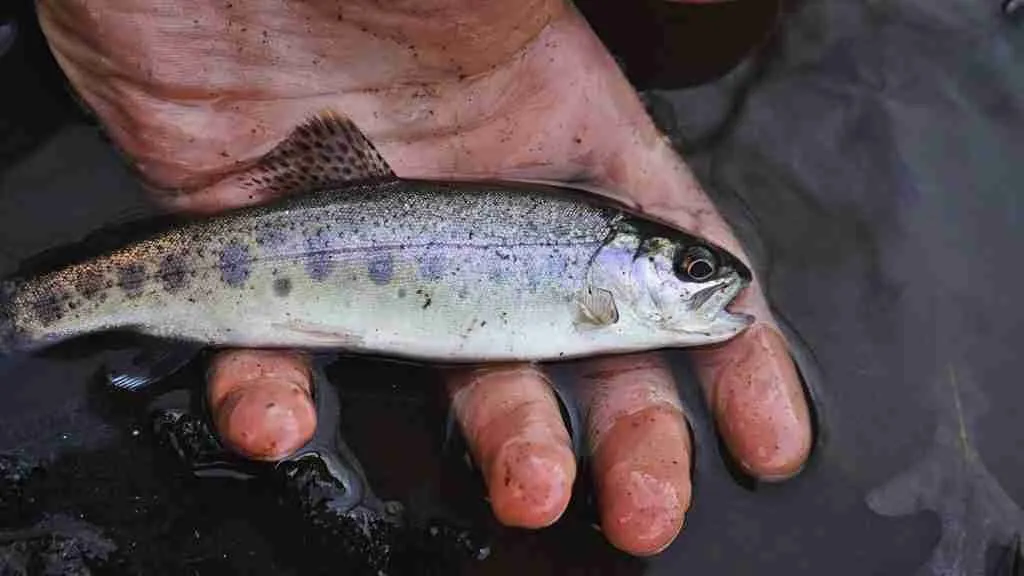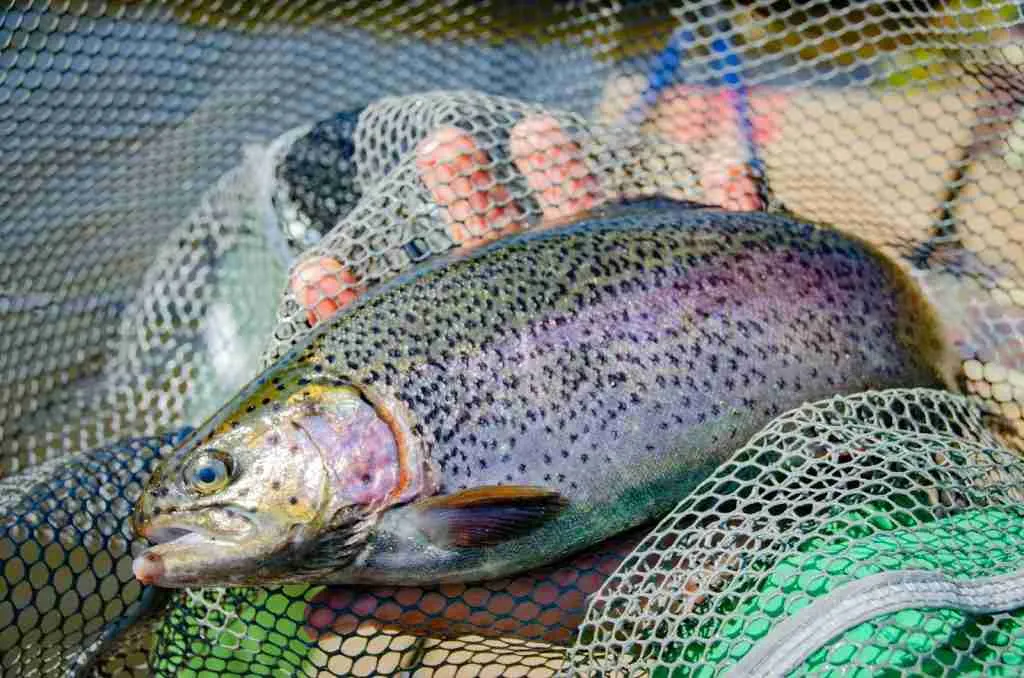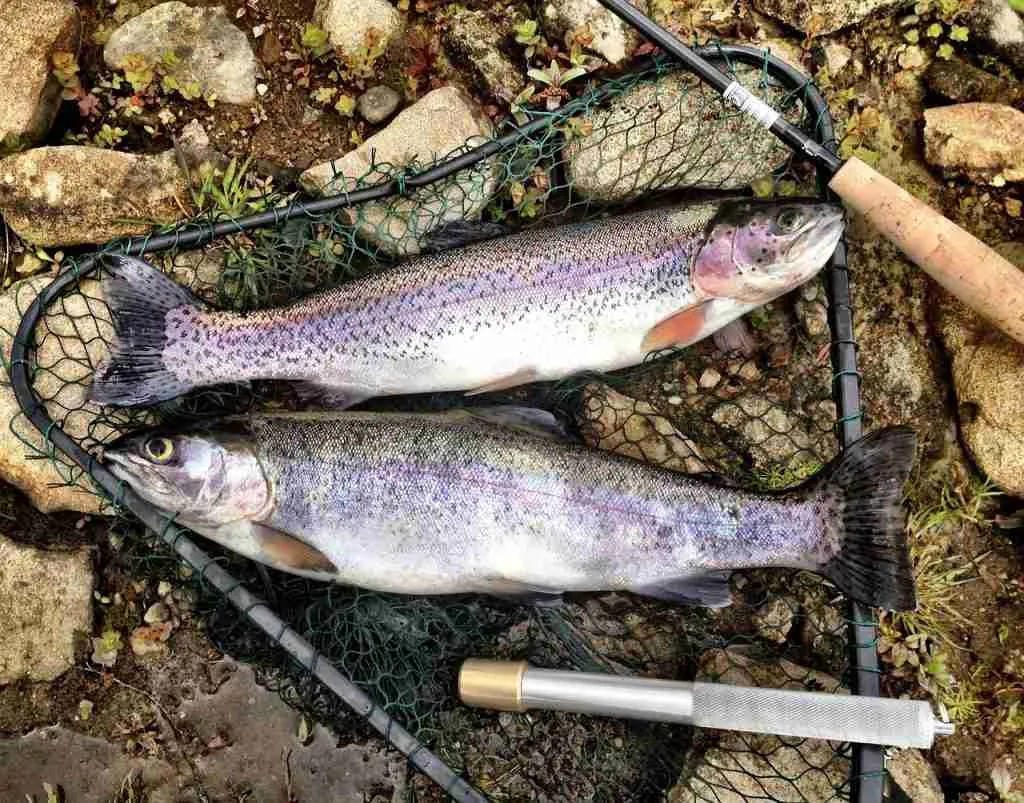25 Facts About Rainbow Trout You Need to Know
-
Rainbow trout are capable of swimming up to 25 miles per hour in short bursts.
-
They have specialized gills that help them extract oxygen from cold water efficiently.
-
They have a strong territorial instinct, especially during the spawning season.
-
They can be found in more than 30 countries worldwide.
-
Their teeth are sharp and well-adapted for gripping slippery prey.
-
Some rainbow trout populations have been known to live in the ocean for up to four years.
-
They are known to change their diet based on the season, consuming more insects during the summer.
-
Their ability to adapt to varying water conditions makes them a symbol of resilience.
-
Rainbow trout are sometimes called “steelhead” when they live in the ocean.
-
Some rainbow trout have been known to leap more than 10 feet into the air.
-
Rainbow trout can change color, especially during spawning, to attract mates.
-
They are known to have a strong sense of direction and can return to the exact spot where they were born.
-
They are one of the few fish species that can be caught on fly fishing gear.
-
They can be trained to respond to feeding times in aquaculture settings.
-
They have been a part of many fishing competitions worldwide for over a century.
Table of Contents
1. Rainbow trout are native to North America, but they’ve spread worldwide.
Though originally found in the cold rivers and lakes of North America, rainbow trout have now become widespread globally. These fish have been introduced to other parts of the world, where they thrive in temperate environments.
As a result, rainbow trout have adapted well to various ecosystems, becoming a sought-after fish for anglers and a key species in many regions.
2. The Rainbow Trout is scientifically known as Oncorhynchus mykiss.
Scientifically known as Oncorhynchus mykiss, the Rainbow Trout is native to the cold-water tributaries of North America. Additionally, the steelhead, also referred to as steelhead trout, is an anadromous variant of the coastal rainbow trout (O. mykiss).
Both share the same scientific classification.
3. They can live in both fresh and saltwater.
While rainbow trout are typically freshwater fish, some populations migrate to the ocean for part of their lives. This adaptation, known as anadromy, helps them grow larger before returning to freshwater to spawn.
Their ability to switch between fresh and saltwater environments shows their incredible adaptability and resilience in different ecosystems.
4. They can grow up to 50 pounds in the wild.
In optimal conditions, rainbow trout can grow significantly, reaching weights of up to 50 pounds. While most wild fish are smaller, some exceptional individuals have been known to reach these impressive sizes.
This growth is aided by a plentiful supply of food and favorable water conditions, allowing these fish to become some of the largest in the freshwater category.
5. Rainbow Trout has 15 different types.

READ ALSO: Fun Facts About Cougar- America’s Largest Cat
The Rainbow Trout encompasses a diverse range of subspecies, totaling 15 distinct types. Among the most renowned species are the Coastal Rainbow Trout (Oncorhynchus mykiss irideus), commonly found along the Pacific coastline, and the Columbia River Redband Trout (Oncorhynchus mykiss gairdneri), known for its vibrant red markings and inhabiting the Columbia River basin.
Each subspecies exhibits unique characteristics, ranging from coloration patterns to habitat preferences, contributing to the overall richness and diversity of the Rainbow Trout species.
6. The largest Rainbow Trout on record weighed 48 pounds from Canada’s Lake Diefenbaker in 2009.
In 2009, angler Sean Konrad reeled in a whopper of a rainbow trout on Canada’s Lake Diefenbaker, shattering the all-tackle world record.
This behemoth weighed a mighty 48 pounds, dwarfing the record held by his twin brother just two years earlier.
7. Their diet is primarily carnivorous, but they will eat just about anything.
Rainbow trout are known to be opportunistic feeders, often eating insects, smaller fish, and even crustaceans. While they primarily eat meat, their diet can also include plants if the need arises.
This adaptability in their eating habits allows them to thrive in various environments, feeding on whatever is abundant in their habitat.
8. They have a diverse range of colors.
One of the most striking features of rainbow trout is their vibrant coloration, which can vary from bright greens and blues to deep reds. Their color pattern is influenced by environmental factors, including water temperature and diet.
The colors are not just for show; they also play a role in attracting mates and providing camouflage in their natural habitat.
9. Rainbow trout are able to detect polarized light, which helps them navigate and locate prey.

READ ALSO: 25 Facts About Dogs You Never Knew
Rainbow Trout possesses the remarkable ability to detect polarized light, a skill that aids them in navigation and prey detection.
This unique sensory adaptation allows them to perceive subtle changes in light polarization patterns underwater, enhancing their hunting efficiency and overall survival in their aquatic habitats.
10. A group of rainbow trout is called a hover.
A cluster of Rainbow Trout is referred to as a hover, signifying their collective presence in a particular area of their habitat. This term reflects their tendency to congregate in groups, often observed in freshwater streams and rivers.
The concept of a hover highlights the social dynamics and behavior of Rainbow Trout as they navigate their environment together.
11. They are a key species for sport fishing.
Rainbow trout are highly prized by anglers due to their aggressive fighting behavior when caught. They are often sought after in recreational fishing, providing both a challenge and a thrill for fishermen.
The popularity of rainbow trout has led to the establishment of many trout-specific fisheries, where they are carefully managed and stocked to support both the fishery and the sport.
12. They can be found on every continent except Antarctica.
Rainbow Trout, a highly adaptable species, inhabit various continents worldwide, except Antarctica. Their distribution spans across North America, Europe, Asia, Africa, and Australia, showcasing their remarkable ability to thrive in diverse environments.
Whether in cold mountain streams, pristine lakes, or even certain coastal regions, Rainbow Trout have established populations across a wide geographic range.
13. They are sensitive to water temperature changes.
Like many fish species, rainbow trout are highly sensitive to fluctuations in water temperature. They thrive in cold waters, typically between 50 and 60°F (10-16°C), and can struggle in waters that are too warm.
This sensitivity makes them an important indicator species for monitoring water quality and climate change effects on aquatic ecosystems.
14. Rainbow trout can jump out of the water, making them difficult to catch.
READ ALSO: 25 Facts About Dogs You Never Knew
Rainbow trout are notorious escape artists. Their powerful muscles propel them out of the water in spectacular leaps, often exceeding six times their body length.
This impressive acrobatics helps them evade predators and navigate rapids, but it also makes them a challenging catch for anglers.
15. They spawn in the spring in gravel riverbeds.
Rainbow trout spawn in freshwater rivers and streams during the spring months. They create nests called “redds” by digging into the gravel beds using their tails.
After laying their eggs, the female guards the redd, while the male fertilizes the eggs. This process ensures the next generation of rainbow trout thrives in their environment.
16. They can live up to 11 years in the wild.
While most rainbow trout are caught at younger ages, some can live as long as 11 years in the wild. The longevity of a trout depends on its environment, food availability, and predation risks.
Trout that are not caught or affected by predators can grow much larger and live longer, reaching their full potential in size and weight.
17. They are one of the fastest swimming fish.
Rainbow trout are known for their impressive swimming speed. They can reach speeds of up to 25 miles per hour when swimming, making them one of the fastest fish in their freshwater habitat.
This speed helps them escape predators and navigate swiftly through their environment, as well as catch prey when needed.
18. Female Rainbow Trout can lay anywhere from 200 to 8000 eggs per spawning season.
Female rainbow trout are masters of maternity. They can release 200 to 8,000 eggs in a single season—talk about a baby boom. But here’s the shocker: only a tiny fraction survive.
This strategy, called r-selection, ensures some offspring make it despite the odds, perpetuating the rainbow trout legacy in the face of predators and environmental challenges.
19. Predators of Rainbow Trout include kingfishers, eagles, herons, raccoons, and humans.

READ ALSO: 24 Interesting Facts About Bobcats: Fierce & Fuzzy
Rainbow trout aren’t at the top of the food chain. They have to watch their backs for various predators. From the skies, sharp-eyed kingfishers, eagles, and herons snatch unsuspecting trout near the surface.
In the water, otters are relentless hunters, while sly raccoons snatch eggs or unwary fish. Even humans, with their clever fishing techniques, pose a big threat.
20. They are often farmed in aquaculture systems.
Due to their popularity and commercial value, rainbow trout are commonly farmed in aquaculture systems around the world. These controlled environments help meet the growing demand for trout while minimizing overfishing in the wild.
Farmed rainbow trout are raised in large tanks or net pens and are carefully monitored to ensure their health and the quality of their meat. These farms also help conserve wild populations by providing an alternative source of trout.
21. They have a highly developed sense of smell.
Rainbow trout rely heavily on their sense of smell to detect food, navigate, and communicate. Their ability to pick up on chemical cues in the water helps them locate food and find their way back to their spawning grounds.
This highly developed sense of smell is also used to detect predators, helping them avoid danger in their environment and ensuring their survival.
22. They are cannibalistic, with larger trout sometimes preying on their smaller kin.
Rainbow trout have a dark side. In times of low food availability, larger trout see their smaller relatives not just as neighbors but as a potential meal.
This cannibalistic behavior ensures they survive despite scarce resources, but it’s a surprising twist for such beautiful fish.
23. They have been featured in many cultural myths and stories.
Across various cultures, rainbow trout have appeared in myths and stories, often symbolizing transformation or renewal. In Native American cultures, the rainbow trout is seen as a symbol of vitality and health.
In addition to their importance as a food source, these fish are often portrayed as figures of wisdom and endurance, representing a connection to the natural world and the cyclical nature of life.
24. These trout are known for their energetic fighting ability.

Don’t underestimate the fight in a rainbow trout. These fish are feisty athletes. Hook one, and be prepared for a heart-pounding battle.
Their powerful muscles propel them on acrobatic leaps, head shakes, and determined runs, testing your skills and reflexes. Reeling in a rainbow trout is more than just catching a fish – it’s an exhilarating tug-of-war with a spirited opponent.
25. They can live in a wide range of pH levels.
Unlike some species that are highly sensitive to pH changes, rainbow trout can tolerate a wide range of pH levels, which gives them an advantage in environments with varying water chemistry. They can survive in waters with pH levels ranging from 6.5 to 8.5, though they prefer neutral to slightly alkaline conditions.
This flexibility allows them to inhabit a variety of freshwater systems, from soft-water streams to more alkaline lakes, contributing to their widespread distribution.
FAQS
Rainbow trout are opportunistic carnivores, primarily feeding on smaller fish, insects, and invertebrates. Their diet consists of aquatic insects, such as mayflies, and smaller fish like minnows. In some cases, they may also consume crustaceans and plant matter, depending on availability in their environment.
On average, rainbow trout weigh between 1 to 5 pounds, with lengths ranging from 12 to 20 inches. However, under ideal conditions, they can grow much larger, with some individuals reaching up to 50 pounds in weight. The size can vary based on habitat, diet, and environmental factors.
Rainbow trout are typically found in cold, clear freshwater rivers, streams, and lakes. They thrive in well-oxygenated waters, usually with temperatures between 50 and 60°F (10-16°C). In some cases, they are also found in coastal regions where they migrate between freshwater and saltwater.
Yes, rainbow trout can live in saltwater, especially the steelhead variety, which migrates to the ocean for part of its life cycle. These trout are known to grow larger in saltwater before returning to freshwater to spawn. Their ability to survive in both fresh and saltwater environments showcases their remarkable adaptability.





